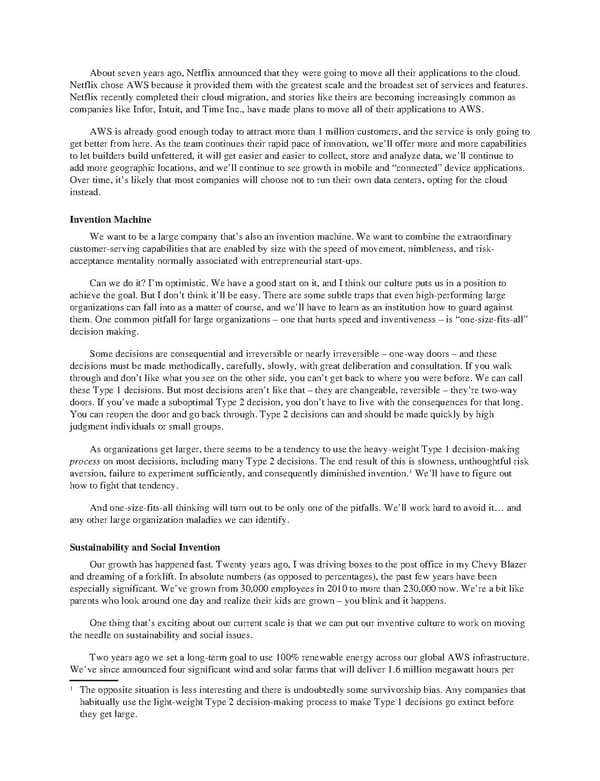About seven years ago, Netflix announced that they were going to move all their applications to the cloud. Netflix chose AWS because it provided them with the greatest scale and the broadest set of services and features. Netflix recently completed their cloud migration, and stories like theirs are becoming increasingly common as companies like Infor, Intuit, and Time Inc., have made plans to move all of their applications to AWS. AWSisalreadygoodenoughtodaytoattract more than 1 million customers, and the service is only going to get better from here. As the team continues their rapid pace of innovation, we’ll offer more and more capabilities to let builders build unfettered, it will get easier and easier to collect, store and analyze data, we’ll continue to add more geographic locations, and we’ll continue to see growth in mobile and “connected” device applications. Over time, it’s likely that most companies will choose not to run their own data centers, opting for the cloud instead. Invention Machine Wewanttobealargecompanythat’salsoaninvention machine. We want to combine the extraordinary customer-serving capabilities that are enabled by size with the speed of movement, nimbleness, and risk- acceptance mentality normally associated with entrepreneurial start-ups. Canwedoit?I’moptimistic. We have a good start on it, and I think our culture puts us in a position to achieve the goal. But I don’t think it’ll be easy. There are some subtle traps that even high-performing large organizations can fall into as a matter of course, and we’ll have to learn as an institution how to guard against them. One common pitfall for large organizations – one that hurts speed and inventiveness – is “one-size-fits-all” decision making. Somedecisions are consequential and irreversible or nearly irreversible – one-way doors – and these decisions must be made methodically, carefully, slowly, with great deliberation and consultation. If you walk through and don’t like what you see on the other side, you can’t get back to where you were before. We can call these Type 1 decisions. But most decisions aren’t like that – they are changeable, reversible – they’re two-way doors. If you’ve made a suboptimal Type 2 decision, you don’t have to live with the consequences for that long. Youcanreopenthedoorandgobackthrough.Type2decisions canandshouldbemadequickly byhigh judgment individuals or small groups. Asorganizations get larger, there seems to be a tendency to use the heavy-weight Type 1 decision-making process on most decisions, including many Type 2 decisions. The end result of this is slowness, unthoughtful risk aversion, failure to experiment sufficiently, and consequently diminished invention.1 We’ll have to figure out howtofight that tendency. Andone-size-fits-all thinking will turn out to be only one of the pitfalls. We’ll work hard to avoid it… and any other large organization maladies we can identify. Sustainability and Social Invention Ourgrowthhashappenedfast. Twenty years ago, I was driving boxes to the post office in my Chevy Blazer and dreaming of a forklift. In absolute numbers (as opposed to percentages), the past few years have been especially significant. We’ve grown from 30,000 employees in 2010 to more than 230,000 now. We’re a bit like parents who look around one day and realize their kids are grown – you blink and it happens. Onething that’s exciting about our current scale is that we can put our inventive culture to work on moving the needle on sustainability and social issues. Twoyearsagowesetalong-term goal to use 100% renewable energy across our global AWS infrastructure. We’vesince announced four significant wind and solar farms that will deliver 1.6 million megawatt hours per 1 Theopposite situation is less interesting and there is undoubtedly some survivorship bias. Any companies that habitually use the light-weight Type 2 decision-making process to make Type 1 decisions go extinct before they get large.
 Amazon Shareholder Letters 1997-2020 Page 80 Page 82
Amazon Shareholder Letters 1997-2020 Page 80 Page 82